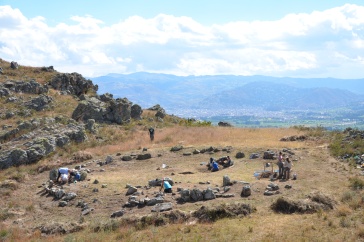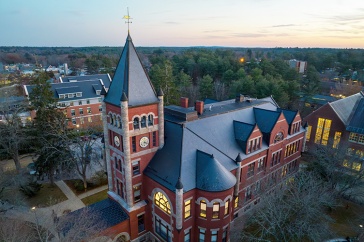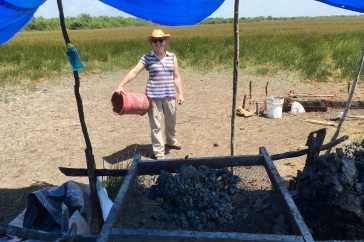|
|

Ken Johnson is senior demographer at the Carsey Institute and professor of sociology at the University of New Hampshire.
Tell demographer Ken Johnson the county you live in and he can tell you a lot about your town, your state, and how that place has changed over past decades.
Pair up Johnson with Haya El Nasser, demographic reporter for USA Today, and she’ll take Johnson’s data and find story angles to boggle the minds of USA Today’s 3.1 million readers.
Recently El Nasser incorporated Johnson’s research on declining fertility into a story about Levittown, Pennsylvania, where, in 1960, Helen Bachman gave birth to one of her five children. That year 15 other children were born on the same block, and the local obstetrician was so busy he often slept in his car. Bachman, now 64, still lives in her old neighborhood but notes that today “out of 75 houses on the street, maybe 15 might have kids.”
“My goal is always to discover and tell the story of the nation, because the nation changes,” El Nasser says, “We’re changing in so many different facets and ways. Once I understand the story, then I’ll find people whose lives are emblematic of that data to give life to those numbers.”
“What I like about working with Ken,” she says, “is that he’s very exact with the data but very understanding of our needs in the media.”
“I'm a demographer,” Johnson says, “and an academic. I lay out the numbers. Reporters aren’t talking to me because they want a point of view. They want someone who will tell them the factual story. That’s why they call me.”
El Nasser is not the only reporter who depends on Johnson for facts and insight. Last year, in addition to USA Today, Johnson was quoted more than 2,000 times in the New York Times, Wall Street Journal, Chicago Tribune, Chicago Sun Times, and numerous other newspapers. He has also been interviewed on ABC World News Tonight, NBC Nightly News, CNN, BBC, and National Public Radio.
Johnson loves to make the numbers come alive for others. As a professor of sociology, he teaches both undergraduate statistics and graduate courses in demography and statistics. “A lot of undergraduates come in to statistics classes reluctantly. It’s usually a requirement,” Johnson says. “I’ll say to them, ‘some of you are going to find out that you really like this stuff.’ And, you know what, they do. You can see it when they compare their hometowns to others. They can see how the nation is changing.”
In 2011, the Rural Sociological Society honored Johnson with its Excellence in Research award honoring his three decades of work on changing patterns of rural migration and population redistribution, the development of a typology for recreational counties, and most recently, the changing racial and ethnic composition of rural America, focusing on Hispanics* and immigrants in new rural destinations.
Johnson’s own domestic migrations tell the story of his passion for rural demography. He grew up in Flint, Michigan, the grandson of immigrants from Sweden and Norway. After graduating from the University of Michigan, he earned his Ph.D. at the University of North Carolina in Chapel Hill.
“My dissertation was on the impact of population loss on rural communities,” recalled Johnson in a Chicago Tribune article. “One day a professor came up to me and suggested that I look at some unexpected new data from the 1970 census—data showing that, after 100 years or more of population loss, some rural areas were growing. … I was hooked.”
After graduate school, he returned to the Midwest, a married man, and took an academic position at Loyola University-Chicago where he taught for more than two decades. He and his wife Brenda raised their two sons in Chicago. In 2007, he and Brenda moved to New Hampshire where Johnson became both a professor of sociology and the senior demographer at UNH’s Carsey Institute.
A well-known presenter at the national level, Johnson understands the value of putting applied research into the local community and strengthening ties between the University and the state. Since his arrival at UNH, Johnson’s schedule has remained packed with presentations to state organizations that have included Leadership New Hampshire, the N.H. State Advisory Committee of U.S. Civil Rights Commission, and the New Hampshire Charitable Foundation (NHCF).
Lew Feldstein, community activist and former president of the NHCF, heard Johnson make a presentation that dispelled the popular notion that young people were leaving the state. “He clarified for me that New Hampshire is not losing young people. There was an abrupt drop in the birth rate in the 1990s,” Feldstein says. “Those young people aren’t leaving. They were never born.”
Under Feldstein’s leadership the foundation grew to become the state’s largest philanthropic organization. Its programs are finely tuned to serve and connect people throughout the state. “It’s been crucial for me to understand migration to the state over the last 10 years—what mixes of people are here and where they live,” Feldstein says. “Ken has been wonderfully helpful.”
Most of Johnson’s work is grant funded from sources such as the National Institutes of Health or the New Hampshire Endowment for Health. Even though New Hampshire’s population is relatively young now, given the state’s baby boomers and its recent influx of retirees, in 20 years Johnson estimates that the state’s elderly population will more than double.
But surprisingly, Johnson is also in the midst of extensive research for the U.S. Forest Service, analyzing population change near the National Forests including those in northern New England. He’s looking at how demographic change will influence the future use and development in and near the forests.
At the Carsey Institute, the walls of Johnson’s office are covered with charts and maps. It’s in numbers of course. But for Johnson, they tell the ever-evolving story of the nation’s people.
* “Hispanic” is used by the U.S. Census. “Latino” is an equivalent term.
Originally published by:
The College Letter
Written by Carrie Sherman. Photo by Lisa Nugent, UNH Photographic Services.
Read more from the College Letter.


















































